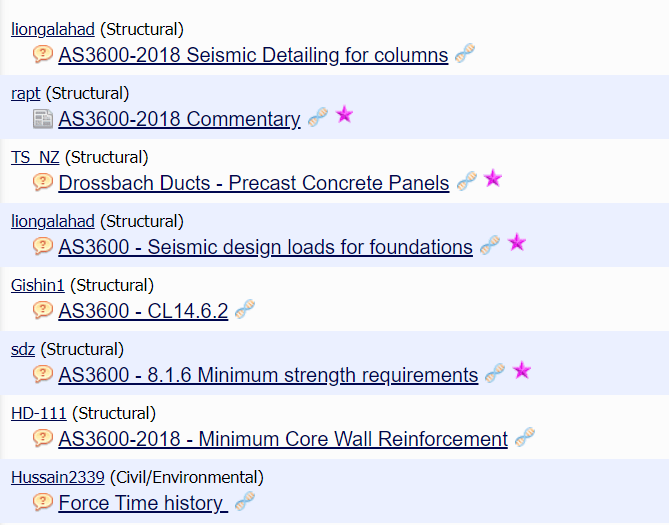li0ngalahad
Structural
Hi all
Clause 14.5.4 of AS3600-2018 A2 says that
At each end of the clear height of a column within a storey, the longitudinal reinforcement shall be restrained by closed fitments for a distance from the end equal to the greater of the maximum dimension of the column cross-section, or one sixth of the least clear height between consecutive flexural members framing into it.
and
Where N* > Φ 0.3 Ag f'c or f’c > 65 MPa , each longitudinal bar shall be restrained by a closed fitment.
implying that if we do not have any of the two conditions above, we do not need have to restrain all bars within a closed fitment.
So basically, because of this, my interpretation was that the requirement is similar to 10.7.4.1 (alternate bars restarined if spacing is <150 and stess is less than 0.3Ag, otherwise all bars restarined - the only difference is the capacity factor, Ill discuss this further below), plus for F'c>65 all bars must be restrained and bars must be always restrained with closed fitments, and therefore single fitments would not be allowed.
Now the commentary is confusing things, as in clause C14.5.4 it suggests that
For columns with concrete strength greater than 65 MPa or where the axial force on the column is greater than the limit in this clause, every longitudinal bar needs to be restrained by a fitment with at least a 135° hook around the bar. The alternate 135°/90° fitment hook arrangement shown in Figure 10.7.4.2 is not acceptable in this case.
So it basically specifying what 10.7.4.2 (iv) prescribeing hook-hook ligs and contradicting completely the clause it is commenting on which only talks about closed fitments (as far as I know a single leg hook-hook tie is NOT a closed fitment).
Due to this I am inclined to follow the commentary, ditch the "closed fitments" requirements of the original clause and simply use the 10.7.4.2 detailing (with the addition of the capacity factor) - with the spacing required by 14.5.4 of course (which is roughly half of 10.7.4.3). Or am I misinterpreting something?
Would be nice to understand how are other engineers on here are interpreting the clause and detailing columns.
----
Regarding the capacity factor, I am a bit puzzled on why the stress check on 10.7.4.1 and 10.7.4.2 is 0.3*Ag*f'c while the requirement for 14.5.4 is Φ0.3*Ag*f'c - i.e. applying the capacity factor Φ. I have always assumed it was a typo (it is also applied to 10.7.3.1 (B)) since the release of the 2018 code and always applied the capacity factor when checking this even where not specifiaclly required, however in two amendments they have not corrected it which makes me think this difference in approach is wanted. If anyone has any insight on this it would be appreciated thank you
Clause 14.5.4 of AS3600-2018 A2 says that
At each end of the clear height of a column within a storey, the longitudinal reinforcement shall be restrained by closed fitments for a distance from the end equal to the greater of the maximum dimension of the column cross-section, or one sixth of the least clear height between consecutive flexural members framing into it.
and
Where N* > Φ 0.3 Ag f'c or f’c > 65 MPa , each longitudinal bar shall be restrained by a closed fitment.
implying that if we do not have any of the two conditions above, we do not need have to restrain all bars within a closed fitment.
So basically, because of this, my interpretation was that the requirement is similar to 10.7.4.1 (alternate bars restarined if spacing is <150 and stess is less than 0.3Ag, otherwise all bars restarined - the only difference is the capacity factor, Ill discuss this further below), plus for F'c>65 all bars must be restrained and bars must be always restrained with closed fitments, and therefore single fitments would not be allowed.
Now the commentary is confusing things, as in clause C14.5.4 it suggests that
For columns with concrete strength greater than 65 MPa or where the axial force on the column is greater than the limit in this clause, every longitudinal bar needs to be restrained by a fitment with at least a 135° hook around the bar. The alternate 135°/90° fitment hook arrangement shown in Figure 10.7.4.2 is not acceptable in this case.
So it basically specifying what 10.7.4.2 (iv) prescribeing hook-hook ligs and contradicting completely the clause it is commenting on which only talks about closed fitments (as far as I know a single leg hook-hook tie is NOT a closed fitment).
Due to this I am inclined to follow the commentary, ditch the "closed fitments" requirements of the original clause and simply use the 10.7.4.2 detailing (with the addition of the capacity factor) - with the spacing required by 14.5.4 of course (which is roughly half of 10.7.4.3). Or am I misinterpreting something?
Would be nice to understand how are other engineers on here are interpreting the clause and detailing columns.
----
Regarding the capacity factor, I am a bit puzzled on why the stress check on 10.7.4.1 and 10.7.4.2 is 0.3*Ag*f'c while the requirement for 14.5.4 is Φ0.3*Ag*f'c - i.e. applying the capacity factor Φ. I have always assumed it was a typo (it is also applied to 10.7.3.1 (B)) since the release of the 2018 code and always applied the capacity factor when checking this even where not specifiaclly required, however in two amendments they have not corrected it which makes me think this difference in approach is wanted. If anyone has any insight on this it would be appreciated thank you


